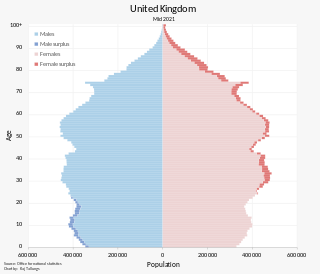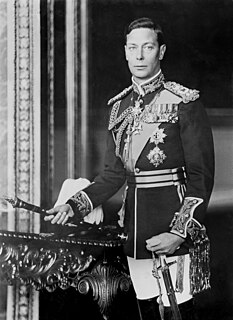Related Research Articles

The United Kingdom of Great Britain and Northern Ireland, commonly known as the United Kingdom (UK) or Britain, is a sovereign country in Europe, off the north-western coast of the continental mainland. It comprises England, Wales, Scotland, and Northern Ireland. The United Kingdom includes the island of Great Britain, the north-eastern part of the island of Ireland, and many smaller islands within the British Isles. Northern Ireland shares a land border with the Republic of Ireland; otherwise, the United Kingdom is surrounded by the Atlantic Ocean, the North Sea, the English Channel, the Celtic Sea and the Irish Sea. The total area of the United Kingdom is 93,628 square miles (242,500 km2), with an estimated 2020 population of more than 67 million people.

The current population of the United Kingdom is estimated at over 67.0 million, as of 2020. It is the 21st most populated country in the world and has a population density of 270 people per square kilometre, with England having significantly greater density than Wales, Scotland, and Northern Ireland. Almost a third of the population lives in South East England, which is predominantly urban and suburban, with about 9 million in the capital city, London, whose population density is just over 5,200 per square kilometre.

George VI was King of the United Kingdom and the Dominions of the British Commonwealth from 11 December 1936 until his death in 1952. He was concurrently the last Emperor of India until August 1947, when the British Raj was dissolved.

The War Measures Act was a statute of the Parliament of Canada that provided for the declaration of war, invasion, or insurrection, and the types of emergency measures that could thereby be taken. The Act was brought into force three times in Canadian history: during the First World War, Second World War and the 1970 October Crisis.

A Commonwealth realm is a sovereign state in the Commonwealth of Nations that has Elizabeth II as its monarch and head of state. Each realm functions as an independent state, equal with the other realms and nations of the Commonwealth.

The New Zealand Census of Population and Dwellings is a national population and housing census conducted by government department Statistics New Zealand every five years. There have been 34 censuses since 1851. In addition to providing detailed information about national demographics, the results of the census play an important part in the calculation of resource allocation to local service providers.

The Allies were an international military coalition formed during the Second World War (1939–1945) to oppose the Axis powers, led by Nazi Germany, Imperial Japan, and Fascist Italy. Its principal members by 1941 were the United Kingdom, United States, Soviet Union, and China.

Coincident full censuses have taken place in the different jurisdictions of the United Kingdom every ten years since 1801, with the exceptions of 1941, Ireland in 1921/Northern Ireland in 1931, and Scotland in 2021. In addition to providing detailed information about national demographics, the results of the census play an important part in the calculation of resource allocation to regional and local service providers by the UK government.

The demography of Scotland includes all aspects of population, past and present, in the area that is now Scotland. Scotland has a population of 5,463,300, as of 2019. The population growth rate in 2011 was estimated as 0.6% per annum according to the 2011 GROS Annual Review.

The First Labour Government of New Zealand was the government of New Zealand from 1935 to 1949. Responsible for the realisation of a wide range of progressive social reforms during its time in office, it set the tone of New Zealand's economic and welfare policies until the 1980s, establishing a welfare state, a system of Keynesian economic management, and high levels of state intervention. The government came to power towards the end of, and as a result of, the Great Depression of the 1930s, and also governed the country throughout World War II.

In the United Kingdom, conscription has existed for two periods in modern times. The first was from 1916 to 1920, the second from 1939 to 1960, with the last conscripted soldiers leaving the service in 1963. It was legally designated as "Military Service" from 1916 to 1920, and as "National Service" from 1939 to 1960. However, between 1939 and 1948, it was often referred to as "war service" in documents relating to National Insurance and pension provision.

The National Registration Act 1939 was an Act of Parliament in the United Kingdom. The initial National Registration Bill was introduced to Parliament as an emergency measure at the start of the Second World War.

A national census in Germany was held every five years from 1875 to 1910. After the World Wars, only a few full population censuses have been held, the last in 1987. The most recent census, though not a national census, was the 2011 European Union census.

A census of the population of the United Kingdom is taken every ten years. The 2011 census was held in all countries of the UK on 27 March 2011. It was the first UK census which could be completed online via the Internet. The Office for National Statistics (ONS) is responsible for the census in England and Wales, the General Register Office for Scotland (GROS) is responsible for the census in Scotland, and the Northern Ireland Statistics and Research Agency (NISRA) is responsible for the census in Northern Ireland.
A declaration of war by Canada is a formal declaration issued by the Government of Canada indicating that a state of war exists between Canada and another nation. It is an exercise of the Royal Prerogative on the constitutional advice of the ministers of the Crown in Cabinet and does not require the direct approval of the Parliament of Canada, though such can be sought by the government. Since gaining the authority to declare war under the Statute of Westminster 1931, Canada has declared war only during the Second World War.

This is a list of national population and housing censuses.
The United Kingdom Census 1931 was a census of the United Kingdom of Great Britain and Northern Ireland that was carried out on 26 April 1931. A census in Northern Ireland had been taken in April 1926, so no census was taken there in 1931. The questions asked were similar to those in 1921, with the addition of a question about everyone's usual place of residence, as opposed to where they actually were on that night.
The United Kingdom Census 1921 was a census of the United Kingdom of Great Britain and Ireland that was carried out on 19 June 1921. It was postponed for two months from April due to industrial unrest and no census was taken in Ireland due to the Irish War of Independence. It was the first census in the UK to ask about place of work and industry, and whether a marriage had been dissolved by divorce.

The United Kingdom home front during World War II covers the political, social and economic history during 1939–1945.
References
- 1 2 General Register Office: 1951 Census Returns. The National Archives. Retrieved 6 July 2017.
- ↑ World War II: 'Wartime Domesday' book showing life in 1939 to be made publicly available online. The Independent , 1 November 2015. Retrieved 6 July 2017.